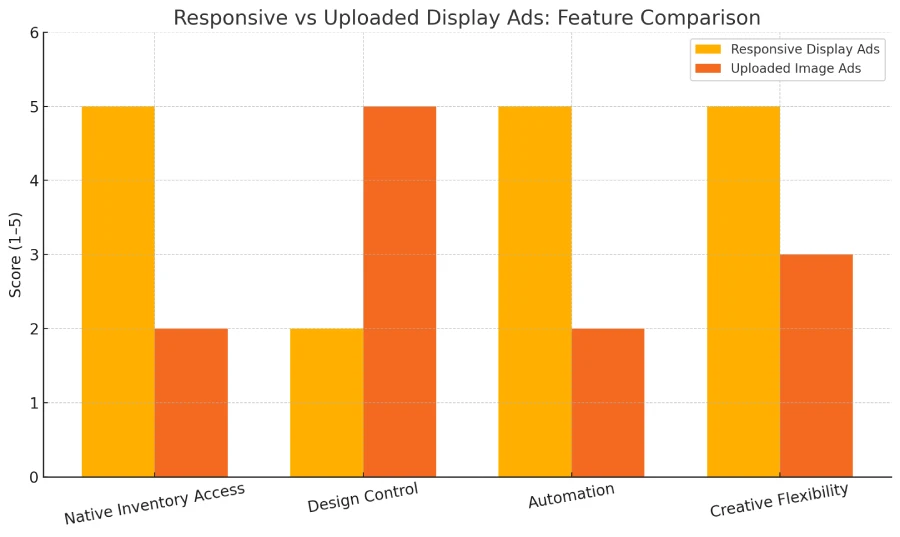When I was preparing for my Google Ads Display Certification (yep, 97% score!), one question that really stood out wasn’t even that hard. But it helped me understand why Responsive Display Ads (RDAs) are so powerful. The question was simple: What’s one benefit of using responsive display ads?
Let’s explore the correct answer, explain why it works, review the incorrect choices, and see a real-world example. I’ll also add a visual comparison chart and FAQs so it’s easy to remember if you’re studying or running a campaign. 💡
Question
What’s one benefit of using responsive display ads?
- They can run on native inventory.
- They can meet exact branding requirements.
- They can be uploaded.
- They can respond to manual A/B testing.
Correct Answer:
✅ They can run on native inventory
Why This Answer Is Correct:
Responsive Display Ads automatically adjust to fit the look and feel of the websites and apps they appear on. That means they can show up in native ad placements — spots on websites that look and feel like regular content (not a boxy banner ad).
Native inventory = places where the ad blends into the page’s layout.
This increases:
- ✅ Ad visibility
- ✅ Engagement
- ✅ Placement opportunities
And it happens automatically.
Why the Other Options Are Wrong:
🚫 They can meet exact branding requirements
- No — RDAs sacrifice control over layout to gain reach and automation.
- If you need to follow strict brand guidelines, use Uploaded Display Ads instead.
Responsive = flexible, not pixel-perfect.
🚫 They can be uploaded
- Not true. You don’t upload RDAs the way you upload image ads.
- You enter assets (headlines, images, logos, etc.) and Google automatically assembles the ads.
RDAs are generated dynamically — not uploaded manually.
🚫 They can respond to manual A/B testing
- Wrong. RDAs use machine learning to test and optimize ad combinations automatically.
- You don’t manually A/B test each version — Google does it in the background.
You can review performance ratings for assets (Low, Good, Best), but it’s not manual A/B testing.

Comparison Chart: Responsive vs Uploaded Ads
| Feature | Responsive Display Ads | Uploaded Image Ads |
|---|---|---|
| Run on native inventory | ✅ Yes | ❌ No |
| Fully customizable layout | ❌ No | ✅ Yes |
| Auto-tested & optimized | ✅ Yes | ❌ No |
| Manual A/B testing required | ❌ No | ✅ Possible |
| Asset-based input | ✅ Yes | ❌ No |
Real-Life Example:
Let’s say you run a startup called EcoTrail Snacks. You create:
- 5 short headlines
- 3 long headlines
- 2 descriptions
- 4 product images
- 1 logo
Google turns this into hundreds of ad combinations. Your ad then appears:
- In a blog post on “10 Best Snacks for Hikers”
- On a fitness app feed that scrolls like Instagram
- In the Gmail Promotions tab, styled like an email
All those are native placements. You didn’t design them manually — Google did it for you using RDAs.
Helpful Resources:
- Google Ads Help – Responsive Display Ads
- Google Smarter Creative with Machine Learning
- Skillshop – Display Certification Path
FAQs:
Q1: What is native inventory?
It’s a type of ad placement that matches the style and format of the content it appears beside.
Q2: Can I use logos and images in RDAs?
Yes! RDAs let you upload multiple assets like logos, images, and videos.
Q3: Do I need to do A/B testing with RDAs?
Nope. Google’s system automatically tests combinations and highlights what performs best.
Q4: What if my brand requires layout control?
Then use Uploaded Image Ads where you have full control over the ad design.
Conclusion:
Responsive Display Ads shine because they go places static ads can’t. Native inventory expands your reach, improves engagement, and helps your brand appear more natural on the web.
✅ If you want maximum visibility and minimal setup, RDAs are your best bet.
Now, if you are ready, you can take the Google Skillshop test for the Google Ads Display Exam. Want more real exam questions with easy answers like this? Follow along — I’ll be breaking down more Google Ads Display Measurement Certification Free examples in the next posts.
